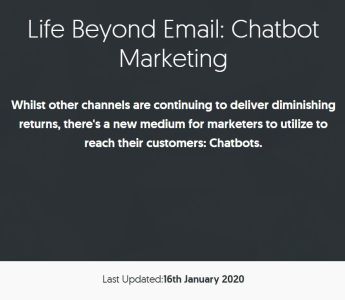Life Beyond Email: Chatbot Marketing, Whilst other channels are continuing to deliver diminishing returns, there’s a new medium for marketers to utilize to reach their customers: Chatbots By Matthew Barby
Recommendation
Chatbots, introduced just a few years ago, have already become familiar tools in customer service, and their capabilities and popularity are only increasing. Marketers who aren’t yet up to speed on chatbots will appreciate Matthew Barby’s clear and useful primer. Serving as the director of acquisition marketing at HubSpot, co-founder of the SEO community Traffic Think Tank and co-host of the Decrypting Crypto podcast, Barby concisely explains how chatbots work, the steps involved in building one and some convincing reasons why you should.
Take-Aways
- Chatbots offer a fresh, versatile, easy-to-use and potentially free channel for reaching customers and building a brand.
- Facebook has made it possible to run chatbots within Messenger.
- Specialized platforms allow you to create a complete chatbot in minutes.
- For best results, give users high-quality content that matches their interests.

Summary
Chatbots offer a fresh, versatile, easy-to-use and potentially free channel for reaching customers and building a brand.
Because of channel fatigue – every channel, even high performers, will see diminishing returns sooner or later – marketers need to be looking for new channels constantly. Facebook pages and traditional email have clearly been declining in reach. Chatbots offer an exciting alternative for reaching consumers and building a brand. Chatbots are rule-based services, some employing artificial intelligence with which users can chat on any of the familiar chat products. Funnel-related examples of how chatbots can work include allowing users to opt in to a newsletter, give people a discount code or collect information necessary to book a meeting. They can also deliver information, like the Politico chatbot that provides news digests.
“Better bot experiences with more engaged audiences are getting 80%–90% response rates.” (Chatfuel head of partnerships Dmitriy Kachin)
Facebook has made it possible to run chatbots within Messenger.
In 2016, Facebook introduced the Messenger platform with chatbot support. This benefits users by giving them the convenience of accessing content without leaving Facebook, and it offers huge opportunities to marketers – who can deliver on-demand content, collect data about users and even receive payments, all via Messenger. When you run an ad directly on Messenger, you can then follow up in Messenger with a chatbot. These capabilities open up massive opportunities on Facebook, but chatbots also function on other platforms, including Slack and Telegram as well as SMS.
“You can set up automation workflows in the same way that you would via email marketing automation.”
Specialized platforms allow you to create a complete chatbot in minutes.
Chatfuel and similar platforms simplify chatbot creation by providing an easy-to-use interface. After designing the chatbot, you build it in Chatfuel by setting up so-called blocks and rules, dragging and dropping them to make a logic-based flow. Rules can act on a user’s yes or no responses or on keywords that the user types, and the flows can incorporate loops. Chatfuel includes plugins that allow you to pull in content by linking to a variety of services. Chatfuel even lets you segment users according to their responses. Chatfuel is free to use for up to 100,000 chats per month.
“Instead of sending your website visitors to a landing page…send them directly to Messenger to grab their content.”
For best results, give users high-quality content that matches their interests.
Before you create a chatbot, know what value it will offer to users. Chatfuel head of partnerships Dmitriy Kachin suggests that broadcast messages will perform best if they offer quality content, if they have relevance for the target audience – you can use segmentation to enhance relevance – and if they use personalization.
“The first thing to do when mapping out your own chatbot is to figure out what unique value it could add to the user.”
Kachin recommends giving users control over what they will receive and how often. More than two messages in a day can turn people off and cause them to opt out.
About the Author
Matthew Barby is director of acquisition marketing at HubSpot and co-founder of Traffic Think Tank, a private membership SEO community. He also co-hosts the Decrypting Crypto podcast.